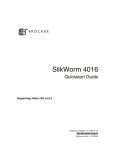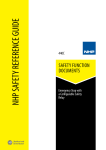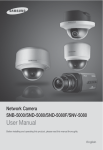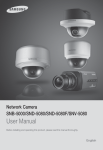Download Q-See QC-SERIES User manual
Transcript
For more information about your new system, look for “QC” on our website or in our online support materials at www.q-see.com/support Remote Monitoring Quick Start Guide QC Series Network NVRs Before You Get Started You will need: This poster is intended to help you get your Q-See security system connected to your network and accessible for remote monitoring. You must have already set up your system and have a basic idea of its operation. There are many additional features which can be customized to your specific needs. More information and instructions are available in the Remote Monitoring Guide included on the CD that came with your system or available for download from our website at www.Q-See.com/Support. For information on how to set up your NVR and cameras, please refer to the Quick Start Guide poster included with your NVR along with the User Manual also included on the accompanying CD. Network Information STEP 1 Establish an IP Address IMPORTANT! This guide will instruct you on how to connect your NVR to a network to allow you to monitor it remotely from a computer or mobile device. • Ensure that your NVR is connected directly to your network router using a Cat 5 or “Ethernet” cable plugged into your NVR’s network port (labelled “NET” or “LAN”). Having a network switch between your NVR and router can cause connectivity problems. Please note that your NVR must be connected to your router with a cable as it will not work with a wireless connection. • You will need your router’s brand, model number and manual. The manual is also usually available on your router’s manufacturer’s website. • The “Manuals and Software” CD that came with your NVR. It contains necessary software and links to other important programs which are mentioned in this guide. • Have a computer connected to the same router as your NVR. If you were unable to obtain your NVR’s Local Network IP Address or Internet IP Address using the Startup Wizard, please proceed with the instructions below. Otherwise, please obtain your DNS address from your router as shown in Steps 2 and 3 before proceeding to Step 5. B C MAIN MENU D SETTING A. Open the Main Menu. B. Click on the Settings icon in the Main Menu. C. Click on the Network icon in the Settings Menu. SEARCH INFO SETTING GENERAL RECORD SETTING SCHEDULE D. Ensure that the box labeled “DHCP” is checked. If it is not, please put a check mark in the box, click on Save and then Exit the window. Reopen the window to see the updated IP address. E. Write down the: 1. NVR’s IP Address 2. Subnet Mask, and 3. Gateway (your Router’s address) F. Exit Menu ADVANCED BACKUP SHUTDOWN PAN/TILT/ZOOM DISPLAY DEFAULT NETWORK EVENTS NETWORK IP Version IPv4 P Address 0 .0 .0 .0 Subnet Mask 255 . 255 . 255 . 0 DHCP Gateway 0 .0 .0 .0 TCP Port 37777 HTTP Port 80 UDP Port 37778 RTSP Port 554 Max Connection 20 Preferred DNS 0 .0 .0 .0 Alternate DNS 0 .0 .0 .0 WAN IP 0 .0 .0 .0 Network Setting Default If you only plan on accessing your NVR from within your local network then you may do so by entering your NVR’s IP address in an Internet Explorer Browser window. To access your NVR from the Internet and via a mobile device, you will need to proceed with Step 2: Port Forwarding. Save Cancel Port Forwarding IMPORTANT! If you were able to successfully connect to your network using the Startup Wizard, you should skip to the CanYouSeeMe.org step at the bottom of this section to obtain your Public IP address. STEP 2 Opening Ports We describe other methods, including Macintosh-specific steps in the Remote Monitoring Guide which can be found on the CD that came with your system. Please note that if you are able to use UPnP, you should NOT forward your ports as this will cause connection issues. To make your NVR accessible from outside of your local network, you have to “forward” ports 85 and 37777 through your router to your NVR’s IP address. The Startup Wizard will attempt to connect you using UPnP. If you received an error message during that process, use one of the two methods below. OPTION A: Opening Ports Using DMZ A. On a computer connected to the same router as the NVR, open a web browser and enter the Gateway (Router’s IP address) you obtained in Part 1 into the browser window’s address bar to access your router. OPTION B: AT&T U-verse® 2Wire® Routers B A. On a computer connected to the same router C. Enable DMZ. D. Enter the NVR’s IP address (Obtained in Step 1 Obtain an IP Address, above). as the NVR, open a web browser and enter the Gateway (Router’s IP address) you obtained in Part 1 into the browser window’s address bar to open your router’s Admin Screen. OR E. Click on Apply or Save to preserve your settings. Browser - Windows Internet Explorer http://10.6.196.6 SEARCH BACKUP I. Leave the next two boxes blank to use the default settings. D B. Click on the Settings and then Firewall. Page tabSafety Tools Web Client Once in Firewall, click on Applications, Pinholes and DMZ. TOOLS INFO Web Client LIVE H. Enter 85 in the From and To boxes for Port (or Range). C Browser - Windows Internet Explorer http://10.6.196.6 B. Locate the DMZ settings in your router. Each manufacturer is different so please consult your router’s manual for the location of this setting. Two examples are shown at right. G. Ensure that TCP is selected. CONFIG J. Click on Add to List. Your router will require you to log in to accept the settings. If you have not created your own password for your router, it is the 10-digit System Key printed on the label on your router between the square brackets “[ ]”. E C. In the Select Your Computer area locate your NVR’s IP address and click on it. 2011-10-06 18:16:49 LIVE F SEARCH G-H D. Scroll down to select User Defined. E. Click on Status Add a new user-defined application. F. In the box labeled Application Profile Name, enter NVR. Master Stream http://81.919.622.24 STEP 3 Obtain DNS Before closing your router’s control window, check your router’s Router Status window to obtain the DNS address - you will only need to use one. DEVICE INFO LOGS STATISTICS INTERNET SESSIONS ROUTING WIRELESS STATUS DEVICE INFORMATION STEP 4 Confirm that Ports are Opened and Obtain Internet IP Address 1 Page 00:24:01:77:f9:00 81.919.622.249 255.255.255.0 81.919.622.24 10.6.196.6 (null) Disabled 3 4 5 6 7 L. Click on Back and then select NVR from the list of Applications. Clicking on Add and then Save. 8 Safety- Windows ToolsInternet Explorer Browser Local Recording Statushttp://canyouseeme.org/ ADVANCEDTo confirm that your ports have been forwarded successfully, go to Open Port Check Tool www.canyouseeme.org using a computer connected to the same 1 2 3 4 5 6 7 8 router as the NVR. CanYouSeeMe.org - Open Port Check Tool A. Enter “85” into the box labeled “What Port?” 9 10 11 12 13 14 15 16 This page will serve as a free utility for remotely verifying a port is open or closed. It will B. Click on the Check button WAN 2 9 10 11 12 13 14 15 16 All of your Internet and network connection details are displayed on this page. MAC Address : IP Address : Subnet Mask : Default Gateway : Primary DNS Server : Secondary DNS Server : Advanced DNS : CONFIG Sub-Stream Browser - Windows Internet Explorer SETTINGS J BACKUP K. Once your settings have been confirmed, repeat Steps H-J, this time entering 37777 for the From and To ports. C. You should see a green “Success” message. If not, return to the NVR’s Network window and, in the Network tab, change port 85 to 81 or 83 and click Apply to save your changes before checking using that new number on CanYouSeeMe. D. Repeat for port 37777. If there is an issue with this port, try 37000 in the same manner as above. This website will also display your Public IP address near the top of the page above the box where you entered your port number. This is the number which you will use to access the NVR using a web browser or your mobile device from outside of your local network (away from the building in which your NVR is located). Please note that if you had to use a different port number than 80, youPage will have Safetyto add Toolsa colon (:) and that port number to the end of the address shown. Example 81.919.622.24:81. be useful for users who wish to check to see if a server or ISP is blocking certain ports. Your IP: 81.919.622.24 What Port? Check Success: I can see your service on 81.919.622.24 on port (85) Your ISP is not blocking port 85 Write down your network addresses: Local Address:___________________________________ Public (Internet) IP Address: ________________________ DNS Number: ____________________________________ Color P.T.Z SYSTEM LOGIN Fixed Local Network Address and Domain Name System (DNS) STEP 5 Static Internal IP (Network) Address Most routers assign connected devices a random IP address that is not currently in use by another device on your internal network. With the exception of 2Wire brand routers, when a router or networked device reboots due to a power loss or other issue, the addresses will change and the port forwarding configuration will no longer work. For that reason, we recommend changing your NVR’s network setting to a fixed, or “static” IP address which will not change. User Name admin STEP 6 Domain Name System (DNS) Password NETWORK Return to the Network Menu. Uncheck the box marked DHCP (A). Click Save. Proceed to Step 6 without closing the window. IP Version IPv4 P Address 0 .0 .0 .0 Subnet Mask 255 . 255 . 255 . 0 DNS enables you to take advantage of additional features including the ability to access!your?NVR@ using#a conventional $ % ^domain + name * and - having _ your system send out e-mail alerts. q w e r t y u i o p | To access these functions, you will need to enter the DNS number that you obtained from your router in Step 4 into the Preferred DNS box (B) into the a s d f g h j k l ; Enter Network Menu. Each block of numbers (between the periods) must be entered z Keyboard x c (right) v as b described n mon the , Quick . Start individually using the Virtual Shift Poster that also came with your NVR. Once you have entered the DNS number, click Save. Close the window. A DHCP Gateway 0 .0 .0 .0 TCP Port 37777 HTTP Port 80 UDP Port 37778 RTSP Port 554 Max Connection 20 Preferred DNS 0 .0 .0 .0 Alternate DNS 0 .0 .0 .0 WAN IP 0 .0 .0 .0 B 1 2 3 4 5 6 7 8 9 0 Network Setting Default Save Cancel Dynamic Domain Name Service (DDNS) This is an optional step which allows you to take advantage of Dynamic Domain Name Service, or DDNS. Not to be confused with DNS from Step 6, DDNS allows you to enter a conventional web address when remotely logging into your NVR from outside of your network. It also allows you to avoid having to repeat Steps 4 and 5 when/if your ISP reassigns IP addresses. Q-See offers DDNS service for free at www.MyQ-See.com and your NVR is configured accept account information from that site. NETWORK A-B NEW USER REGISTRATION EMAIL ADDRESS PASSWORD A. Open a browser window and go to www.MyQ-See.com B. Register with the website and follow the instructions for creating a domain name. The website will display your pubic IP address and your domain name which will look like this: http://example.myq-see.com C. In your NVR, open the Network window. D. Click on the Network Setting button at the bottom to open the Network Setting window. E. Check the box to the left of DDNS and double-click on DDNS itself to open the DDNS window. F. Select MyQ-See.com in the DDNS server pull-down menu. PASSWORD CONFIRM FIRST NAME I. When you return to the Network window, ensure that the DDNS box is checkmarked before clicking on Save as well before closing. P Address 0 .0 .0 .0 Subnet Mask 255 . 255 . 255 . 0 DDNS Gateway 0 .0 .0 .0 UPNP Port Forwarding TCP Port 37777 HTTP Port 80 EMAIL Mail Sever : 25 UDP Port 37778 RTSP Port 554 FTP Record FTP : 461.966.106.12 Max Connection 20 Register 0.0.0.0 : 8000 Preferred DNS 0 .0 .0 .0 Switch Settings 10.1.1.1 Alternate DNS 0 .0 .0 .0 WAN IP 0 .0 .0 .0 Network Setting My first phone number Default IP FILTER DHCP ANSWER E No Available DDNS Setup DDNS D F DDNS Type I Save Server IP Cancel Port User Name Password Q-SEE DDNS Enable myq-see.com 85 Default Save G Update Period CONFRIM YOU’RE HUMAN Trusted Sites : 0 PPPOE Domain Name G. Enter your account information – including the user name and password that you used when creating your domain name . H. Click the Save button to preserve your settings. IP Version LAST NAME SECURITY QUESTION.. NETWORK SETTING IPv4 300 sec. New Captcha Enter the text you see above Submit Reset Default H Save Cancel Can Accessing Your NVR Remotely STEP 6 Using the Pro Surveillance Software (PSS) Now that your ports have been successfully forwarded, you are now able to access your NVR from a computer using Internet Explorer or the Pro Surveillance Software included on the CD that came with your system. PSS allows Mac and PC users a method to remotely monitor their NVR in a way that is not browser-dependent. PSS is compatible with Windows Vista and 7 as well as Mac OSX 10.6 and 10.7. The software interface is identical across computing platforms so both PC and Mac use is described below. Mac users may have to first install a helper program called XQuartz. Instructions for that additional step along with an expanded manual for the software is included on the disk. Whether you are monitoring your NVR from a computer on the same local network (LAN), or on one at a remote location (WAN/Internet), the procedure is the same. The only difference is that for LAN access you will be entering your NVR’s IP address, which you obtained in Part 1 Obtain an IP Address, while for Internet access you will use the Public IP Address which was shown at the end of Part 2 when you visited www.canyouseeme.org C. Before you can monitor your NVR, you must first connect to it with PSS. 1. Click on the blue Full Menu icon to the right of the Setting Manage button in the Tool Bar on the right side of the display. D. The NVR will now appear in the Device List at the top of the Tool Bar. Click on the device name to expand the listing and you can add cameras. 2. Select Device Manage to open the Device Manage window. PC users need only click on the Install PSS Software for Windows button, located in the Manuals and Software CD’s Remote Monitoring on-screen menu ( below, left) to begin the installation. Mac owners will need to open the CD conventionally, and navigate to the folder containing PSS (below, right) and click on the file named PSSSetup.pkg to install. 3. Click the Add button and enter the NVR’s IP address (Section 1.1) or DDNS address (obtained in Section 8.5), port number, your user name and password (which are the same that you use to log into the NVR directly). You can also give the NVR an identifying name and you can add a note in the Description field. E. Choose the screen view format you wish to use and then click on the segment of the screen where you want to place the first camera. Then, click on the camera number in the Device List to add that camera. Repeat by selecting a new area. The area highlighted in green is the current camera view. Clicking on a camera icon while a camera view is highlighted will replace that view with the channel you just selected. You can also add other types of devices such as a network backup storage drive using this window. Leave Login Type at its default Network Type TCP setting. A. Once you have installed PSS, click on the icon to launch it. B. Enter the User Name and Password in the appropriate fields. The default user name and password are admin and admin. It is strongly recommended that you modify your password for improved security. PSS You can return to this window to update your passwords, add or remove other devices and make network access changes if need be. 4. A prompt will pop up at the bottom right of the screen to indicate that the NVR has been added to the program. Live monitoring and recorded video playback takes place in the Real-Time Monitor section of the window. The number of screens being viewed at once is set with the Image View Options at the bottom of the screen, but at any time, you can double-click on a channel in multi-view mode to make it a single-screen view. Double-clicking on the screen will return it to its place in the multiview display. Email Alerts STEP 8 Sending Email STEP 9 Setting E-mail Triggers Your NVR can send e-mail notifications to up to three email addresses. While only one recipient can be set up within the NVR itself, additional recipients can be specified using PSS. Please see the Remote Monitoring Guide or the PSS manual for specific instructions if you need to add more than one receiving email address. Depending on your NVR’s settings, the system can generate heavy email traffic. For that reason, we recommend creating a dedicated email address specifically for the system to send alert notices. If you do not have your own email system A. Click on the Network Settings button at the bottom of the window. Ensure that the box to the left is checked before clicking on Email in the Network Settings window. (such as corporate mail server) you should consider using a free e-mail provider. However, because many free email services allow only a limited amount of email traffic we specifically recommend using Google’s Gmail service with its higher limit. Similarly, you will want the alert emails to go to a different account than the one sending them. This will ease your management of these alerts. Other services will have different values and these can be found in that provider’s Options settings. NETWORK IPv4 P Address 0 .0 .0 .0 B. Fill out the required information. Gmail settings are shown: Subnet Mask 255 . 255 . 255 . 0 SMTP Server – smtp.gmail.com Port – 465 Anonymous – Leave this unchecked for Gmail. Private mail servers may allow you to send e-mail without a user name or password. User Name and Password – Enter the email address along with the password you used to create the account. Receiver– This is the email address that will receive the alerts. Sender – This is the ID that will show up in the “from” field on the e-mail. It can be the sending email address, or it can be a nickname, such as the model or location of the NVR. Title – Putting in a distinct subject line for your email alerts will help you organize and keep track of the email traffic generated by your system. Attachments – Enabling this allows your NVR to send emails with snapshots attached. Encrypt Type – Select SSL for Gmail. Other services may vary. Event Interval – This will limit the number of emails sent within a specified time period. The minimum delay is 3 Gateway 0 .0 .0 .0 TCP Port 37777 HTTP Port 80 Receiver UDP Port 37778 RTSP Port 554 Sender Max Connection 20 Title Preferred DNS 0 .0 .0 .0 Attachment Alternate DNS 0 .0 .0 .0 Encrypt Type NONE WAN IP 0 .0 .0 .0 Event Interval 3 Questions? Your NVR can send e-mails with still image snapshots attached when an event occurs. Set the number of snapshots, the time between them and their quality through the Record Setting menu. See Section 4.3 in the User Manual. EMAIL IP Version SMTP Server DHCP smtp.gmail.com Port 465 Anonymous User Name Password Interval RECORD SETTING Main Stream Channel 1 Compression H.264 Resolution D1 Frame Rate (FPS) Mode 25 60 Save Cancel minutes. Health Enable – Checking this box will allow the NVR to regularly check that the email account can be reached. You can adjust the frequency of this check using the Interval setting. C. Press the Test button. The NVR will check to see if it can connect to the mail 24/7 Technical Resources at www.Q-See.com/support Default H.264 Bit Rate Type Image SizeConstant Trigger 7 D1 Constant 4 Image Quality Bit Rate (Kb/S) 2049 Snapshot Frequency 160 1 SPL Reference Bit Rate 384-2048Kb/S Audio/Video Save OVERLAY Cancel SNAPSHOT Copy Paste Default Save Cancel EVENTS Set which type of event triggers an email plus which cameras will take snapshots in the Events menu. See Section 3.7 in the User Manual. Min. Min. Event Type OK Cancel Motion Detect Channel 1 Sensitivity 3 Enable Region Select Trigger Period sec. sec. Alarm Continue 1 2 3 Show Message 0 Record Continue 0 Hold Time Set Alarm Out Alarm upload 10 sec. Send Email Record Channel 1 2 3 4 5 6 7 8 PTZ Activation Select Tour 1 2 3 4 5 6 7 8 1 2 3 4 5 6 7 8 Snapshot Copy Default Extra Stream SNAPSHOT CIF DVR ALERT Health Enable Network Setting There are several types of events that you can set to trigger an e-mail alert. Alerts can be triggered when motion is detected, if the hard drive fails, or video is lost. Full explanations for setting these triggers are available in your manual be we present some highlights here: Paste Default Save Cancel Test server. A message will pop up indicating success or error. D. Click OK to save your settings before closing the window. E. Make sure that the check box next to Email is selected in the menu before clicking on Save at the bottom of the window to save your settings. Customize alarm responses to motion detection and video loss in the Alarms menu. See Chapter 6 in the User Manual. ALARM Local Alarm Event Type Enable Set Trigger Period Alarm Out 1 2 3 Alarm Upload Show Message Record Channel Alarm In 1 Type Normal Open 5 sec. Alarm Continue 10 sec. Hold Time Send Email 1 2 3 4 Set PTZ Activation Tour 1 2 3 4 Snapshot 1 2 3 4 Rec. Continue 10 sec. Buzzer Default Copy Save Cancel www.Q-See.com















